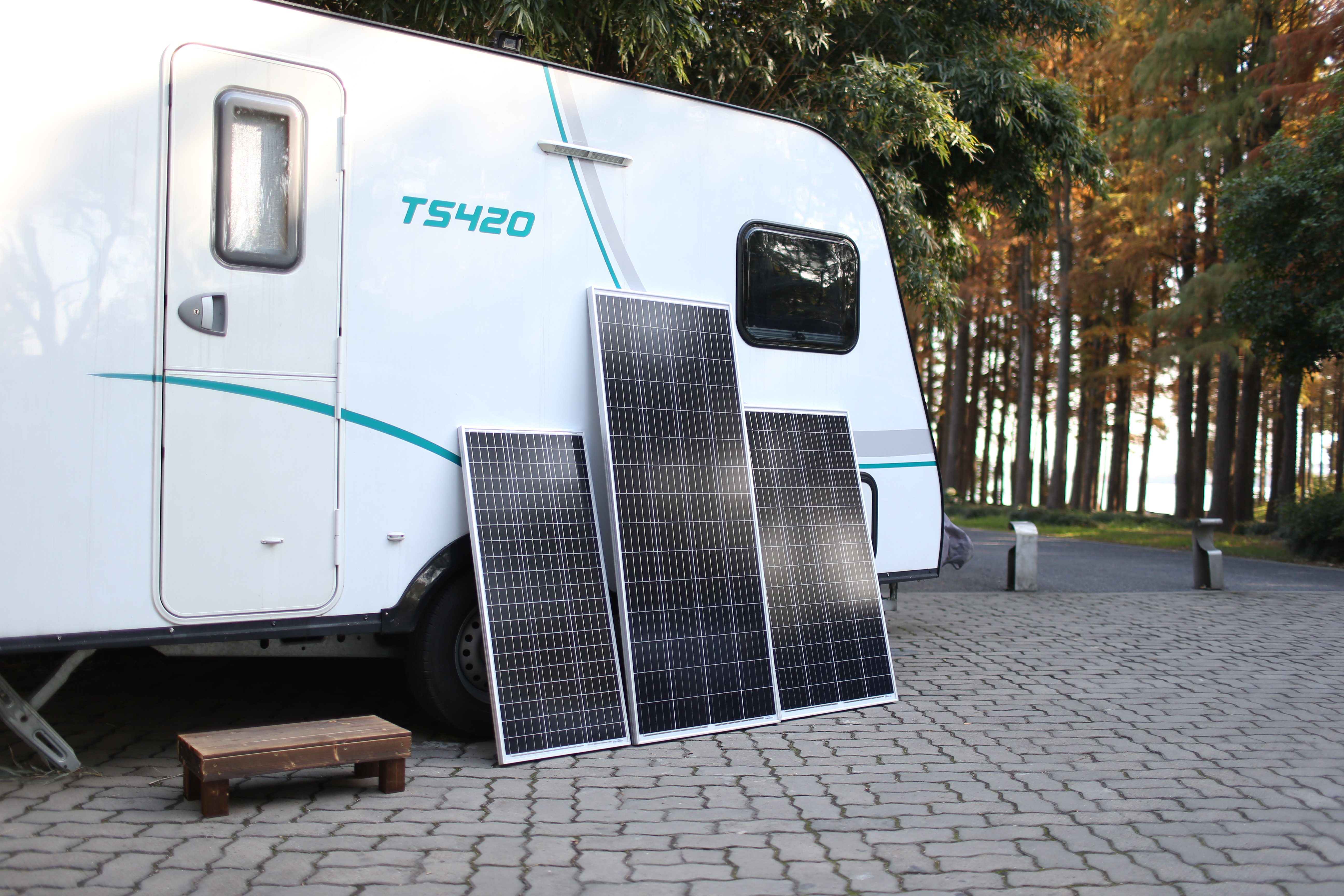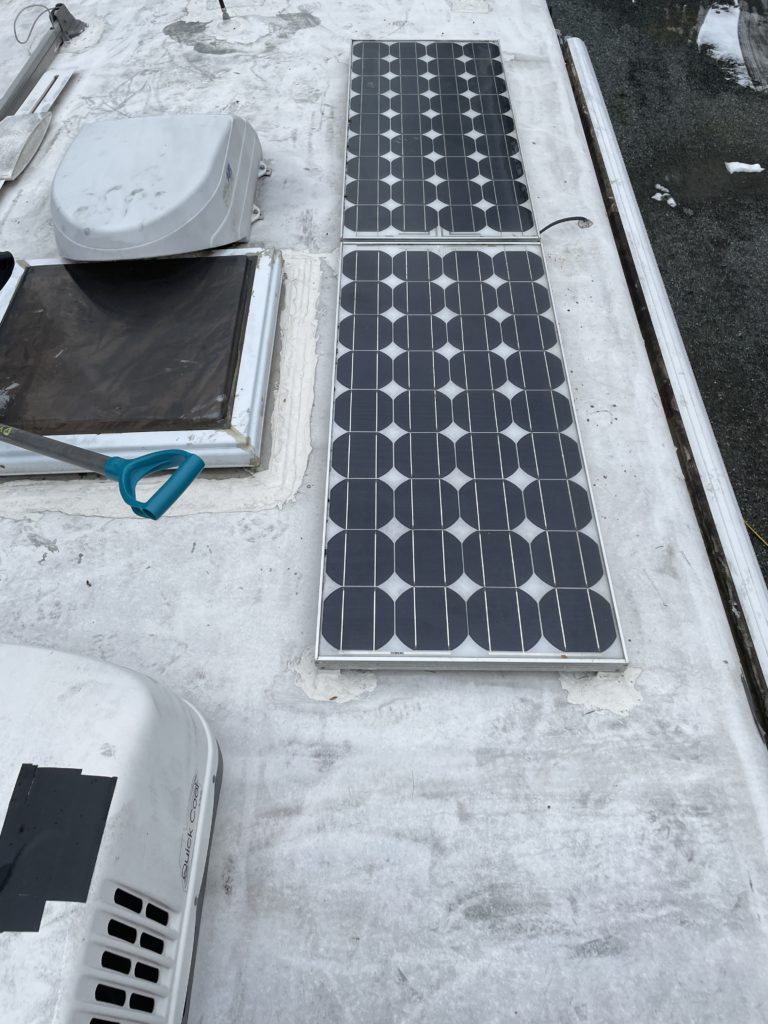Solar For RVs – How To Choose a Solar System
Please note if you click on the links on this page I get a very small percentage at NO cost to you at all. It is the only way this website can stay alive.

I’ve been living off Grid in my Pleasureway since October, it’s now March. Although I made sure to buy a van that was totally capable of boondocking for long periods of time, I still want/need solar. There are a couple of reasons why, the most important one being that my house battery just isn’t loving its workload these days. I haven’t been watching tv or running the microwave or really doing much besides using the fridge and furnace. Then there was the addition of my Diesel Air Heater. What a nightmare that was read about that here.
Solar For RV – The Basics
Having enough power when you’re off the grid is one of the most challenging parts of van life and RV life. It’s great to have an onboard generator and I am lucky enough to have one in my AClass and my Campervan. Running the propane generator at night and in the morning just wasn’t charging my 75AH AGM enough. I am aware that is a small battery but it is the only battery that fits in the box in the back of my van and space is a premium I have since purchased a 100ah lithium battery that will tie into my solar system once it’s installed. I’m doing some research on running the two different types of battery in parallel, comment on this post if you have experience with that.
Solar Calculator
There are a few things you need to know before getting started on your journey buying solar for your RV. You will want to calculate how much power you need on a daily basis. Here is an online calculator you can use. Most, if not all, prebuilt RVs have 12v systems that run your lights, kickstart your fridge if it’s on propane, and will help ignite your furnace. The 12v system has a battery usually an AGM will come with your rig. All my research has shown me that a lithium battery is the best way to go, we will discuss batteries a bit more down below.
Inverter / Solar Generator
If you want your solar for RVs that does more than just charge your house battery you will need an inverter. An inverter is different from a converter. Converters are electrical devices that convert the voltage from alternating current (AC) to direct current (DC). Inverters are electrical devices that convert the voltage from direct current (DC) to alternating current (AC). A converter is what you need to charge your batteries when plugged into ‘shore’ power a converter is what you need to make the plugs in your rv work when you are running off the grid. If you’re starting from scratch you are going to need to decide if you want a built in system or if you want to be portable. There are so many great choices out there right now for portable solar panels and ‘solar generators’ that are a charging system, a battery, and several outlet plugs to run multiple items at the same time. Again, these come in all different sizes so you really want to figure out what you can’t live without on the road and go from there.
Renogy all in one
I purchased an all-in-one kit from Renogy. I have a discount code for this if you sign up for my email list. I wanted to make sure I was getting a system that would work well together. I also wanted it to come with most of the things my RV tech would need for a quick install. I’m not 100% sure that the two 100w panels will fit on my roof but I’m optimistic. Thinking I will remove the TV antennae as I never use it anyway. The general consensus seems to be that anything less than 200w isn’t enough if you’re boondocking. Please be aware I was not rewarded or paid to purchase the Renogy system for my camper van, I will get a small commission if you buy their product using my link at no extra cost to you. I didn’t get a discount of any kind.

Solar For RVs – Boondocking – Rooftop or Portable
Now that you have an idea of how much solar you need for RV boondocking, you need to decide if you are going to do a rooftop rigid install, go with the flexible panels, or have a portable system you put out in the sun, or drag into a coffee shop to charge up, yes people do that, I’ve even taken mine into the gym with me to charge while I take a shower and dry my hair! My big AClass came with solar installed and when I went to talk to a professional about what would be best on my the roof of my Sprinter/Pleasureway he determined that the lumps and bumps on the top of my sprinter would make the flexible panels harder to install. The rigid panels are quite a bit more sturdy and can handle the weight of snow and a strong gust of wind. The only problem is I need to have the panels professionally installed and it has to be above 5 degrees Celsius or your sealants will not seal. So here I am with a week off of work and it’s too cold to put in the solar system that I need for when I go back to work!!! Murphy’s law I guess, that Murphy guy must have been a bit of a jerk!
Installed Roof Mount Solar Panels VS. Portable
A roof mount rigid system is proven to be able to stand up to high winds and inclement weather. They have been around forever, you don’t want to walk on them or anything, you do want to try to keep them clean, but for the most part, you install them and forget they exist. They charge your batteries they are worry-free. Except for the holes you have to drill in the roof of your RV or van to install them properly. This is a pretty big source of anxiety for anyone who owns a camper. The fear of causing leaks is something that keeps me up at night. Another perk to the rigid mount style is you can use brackets that will adjust to the angle required to get the most sunlight.

Installed versus portable solar for RVs can be a hard choice if you’re doing a DIY van build. There are some really great all-in-one systems for around a thousand dollars that have a decent-sized battery bank and come with solar panels. The great thing is these units are complete and very versatile as well as being lightweight and totally portable. You could pop one of these little solar generators into a cupboard somewhere charge it when you are plugged in or charge it with a portable solar panel. Very easy to do yourself. The price is comparable to a roof mount system unless you were going to install your own, I’m looking at roughly 8 hours at 100$/hour to get mine installed.
Top 5 Portable Solar For Campers – Solar Generator- All In One
Below is a list of the most popular 1000w Solar Generator systems. These solar for rvs generators can be sold as a stand-alone units or they can be sold with their own portable solar panels.
Renogy – Phoenix 1000
Ecoflow – Delta Mini 1260
Anker – 555 PowerHouse
Bluetti – 600W Power Station
Jackery – 1000
If you go with the flexible panels the challenge is mounting them on your roof that will withstand the high winds of your journey to your destination. If you are drilling holes anyway, you might as well go with the rigid mount because they are built to last longer. The rigid ones are also quite a bit cheaper. If you are concerned about the weight added to your rig, which many folks are, then keep in mind flexible panels are a fraction of the weight of the old-school rigid panels. Just be aware that they are more expensive and might fly away. There are pros and cons to either system and you need to determine which is best for you! I personally need a professional installer regardless so I went with the much less costly rigid mount.
Choosing the right battery for your off-grid life
Size does matter… when it comes to batteries. Take a look at the calculator we shared above, you need a large enough battery bank to use all the gadgets and devices you need to live your life off grid. You need a big enough solar panel to fuel the battery you choose. There isn’t much point having 400ah batteries if you only have a 100W solar panel to charge them with. The standard AGM deep cycle battery is designed to be happiest if it never gets below a 50% charge, seems a bit silly I know, that’s why I just purchased my first 100ah lithium battery.
Lithium batteries are hellah expensive but they live a lot longer and you can run them down to zero without damaging the cells. They are much lighter which for me is very important. When I had to wrestle my old dead battery out of its little cage below my couch it took me a solid 30 minutes to get it out. Wrestling with a battery in the Canadian Tire parking lot in the dark of night is not my idea of a good time. AGM batteries weigh almost three times as much as their lithium cousins do.
DC-DC Chassis Charging System for Lithium
One thing you need to keep in mind if you have a pre existing system in your motorized rv your chassis will likely be charing your house battery when you drive. If this is the case and you install lithium batteries you will need a DC to DC charger controller. Same if you have an onboard generator your gennie also needs to send a different level of charge to your lithium battery than it did to your AGM.
You do need to keep a lithium battery at a comfortable temperature, but many of them now have built-in heating systems to combat their dislike of the cold. I’m full-time in my van this winter so I won’t be letting it get below zero in the cabin anyway. If the van is going to be left unattended I can easily pull out the lithium battery and store it inside somewhere. For a cost comparison, my 75ah AGM battery cost 210 CDN after tax and my lithium 100ah cost 491 and it came with a charger. That’s a significant markup but when weighing the pros and cons I believe it to be worth it. I’ll know more soon as it’s arriving in a few days! Here is a link to the battery I chose (please note I was not paid in any way to purchase this battery I do get a very small kickback if you buy using this link)
So now you are all set, you have decided between portable, rigid, or flexible, if you are buying a new battery or using the one that came with your RV, you have a charging system that works with your panel and your battery, you have an inverter if you want to run your A/C plugs in your rig, now how do you keep track of all the amazing power you are now harnessing from the sun… Chances are your charge controller has a display but I also picked up a Bluetooth module that will allow me to see a lot more that is going on via an app on my phone. No internet is required as it’s Bluetooth. It has a signal range of 82’ so I can monitor from inside while I’m working. Make sure you get one that works with the charge controller you bought! They aren’t all interchangeable.
Solar for rvs is just one of many things that will help your RV survive without hookups.
Here are a few of my other blog posts you might find interesting:






